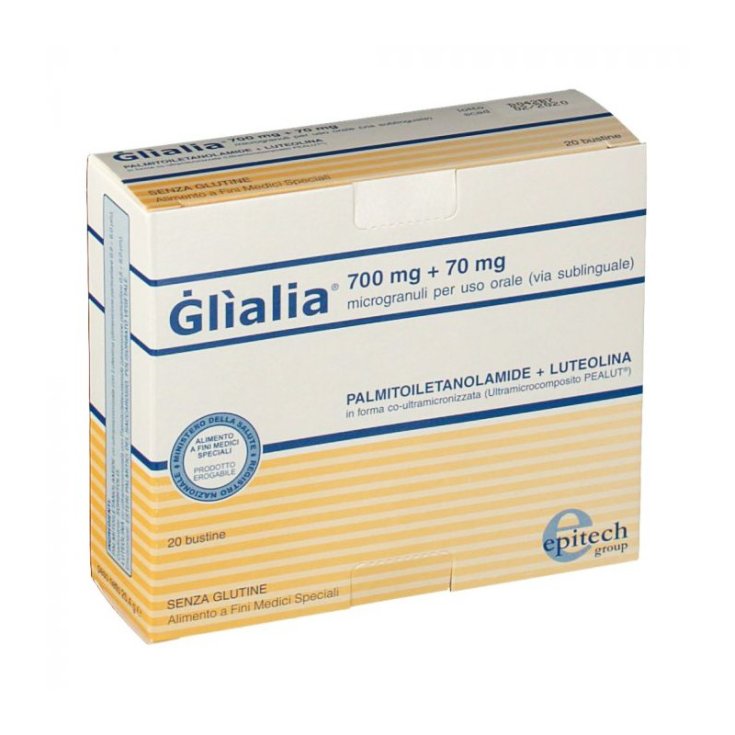Glialia 700mg + 70mg 20bust

- Brand: EPITECH GROUP SpA
- Product Code: 923787814
- EAN: 8031359080605
- Availability: In 10 - 14 Days
- Purchase 3 items for 36.09€ each
- Purchase 4 items for 35.36€ each
- Purchase 5 items for 34.62€ each
Glìalia food supplement 700mg + 70mg
The characteristics of Glialia
Warnings and precautions for use Glialia
What is Glialia used for?
Glìalia is a food supplement that acts as an antioxidant in cases of neurological-inflammatory disorders affecting the Central Nervous System (CNS) caused by strokes, transient ischemias, dementia, parkinson's and post traumatic states. The supplement has the function of promoting and improving the life of macrophage and astrocytic cells, attacked by oxidative stress.
The characteristics of Glialia
Food for special medical purposes.
Microgranules for sublingual use, yellow in color with rapid disintegration and high absorption.
Palmitoylethanolamide
It is a natural endogenous lipid substance with an N-acylethanolamide structure which in the organism has the function of physiologically intervening to maintain intersystemic tissue homeostasis.
Luteolin
It is also a natural substance belonging to the flavone family, endowed with considerable and peculiar antioxidant effects. The association Palmitoylethanolamide and Luteolin in co-ultramicronized form (ultramicrocomposite PEALUT) allows the two active principles to exert a synergistic effect in the control of the neuroinflammation induced by different endogenous and exogenous noxae in the Central Nervous System; this control is carried out through the inhibitory modulation of cells non-neuronal - astrocytes, microglia, mast cells - normally responsible for ensuring the homeodynamic balance of the central nervous tissue.
Glìalia is to be used under medical supervision in subjects with disturbances sustained by neuroinflammatory processes associated with: transient ischemic events (TIA); post-ictal states on an ischemic basis; post-traumatic states of the CNS; states of cognitive decline (Mild Neurocognitive Disorder - Mild-NCD); early stage dementia; early stage parkinsonism; inflammatory demyelinating diseases; diseases of the neuron; mood altering states.
Ingrediants
| for 1 bag | |
| Palmitoylethanolamide | 700 mg |
| Luteolin informs co-ultramicronized (Ultramicrocomposite PEALUT®) | 70 mg |
| Blend of excipients (Sorbitol, Polysorbate 80, Sucrose Palmitate) | 500.00 mg |
Glialia dosage
Glìalia microgranules for sublingual use must be used under medical supervision following acute events associated with neuroinflammation in the CNS (post-ictal, post-traumatic situations) or, as an attack therapy, in the initial states of promptly diagnosed neurodegenerative diseases; it is recommended to take daily for cycles of 20-30 days, possibly repeated using, when possible, the sublingual route.
Warnings and precautions for use Glialia
Use under medical supervision.
The product cannot represent the only source of nourishment.
Keep out of the reach of children under 3 years of age.
Interactions: not highlighted.
Pregnancy: administration of the product during the period of known or presumed pregnancy is not recommended due to insufficient data regarding the use of the Palmitoylethanolamide and Luteolin combination in these situations.
Effects on ability to drive and use machines: Palmitoylethanolamide and Luteolin, at recommended doses, do not affect the ability to drive and use machines.
Undesirable effects: no undesirable effects have been reported even after long-term administration and high doses of Palmitoylethanolamide, nor have there been any reports of addiction or dependence. In humans, the administration of Luteolin 100 mg / day for 4 months has been shown to be optimally tolerated and safe.
Overdose: There are no known clinical cases of overdose.
Pharmacological properties
Health Authorization Category (Ministry of Health): Food for Special Medical Purposes.
Pharmacodynamic properties
Palmitoylethanolamide is an endogenous N-acylethanolamide, devoid of micotropic effects. Preclinical studies have shown that Palmitoylethanolamide acts, in a pleiotropic way, on the mechanisms of neuroinflammation, exerting an effective neuroprotective effect. The use of translational experimental models has clearly shown that Palmitoylethanolamide is able to act on central neuroinflammation through the synchronic modulation of non-neuronal cells (astrocyte, microglia, mast cell) thus determining effective neuroprotection.
Luteolin exhibits a high normalization of the local oxidative state associated with neuroinflammation in the CNS. The available data demonstrate how the association between Palmitoylethanolamide and Luteolin, administered in the form of ultramicrocomposite.Pealut obtained by co-ultramicronization, is highly synergistic on the mechanisms of neuroinflammation in the CNS.
Mechanisms of action
Recent studies have shown that the administration of Palmitoylethanolamide + Luteolin, in the form of the Pealut ultramicro-composite obtained byco-ultramicronization in the 10: 1 mass ratio, increases the cell viability of both macrophage and astrocytic lines subjected to oxidative stress. synergistically the peroxidation of lipids, mitochondrial dysfunctions associated with cell apoptosis, the production of oxidonitric (NO) and the expression of inducible enzymes (NO-synthase and cycle oxygenase-2) .Similar results have been observed in organotypic cultures of damaged hippocampus. Ab1-42 amyloid protein fragment. In ischemic models Pealut ultramicrocomposite has been shown to completely protect neurons from cell death by confirming the synergistic effect of the two molecules in the co-ultramicronized form.Pealut has demonstrated its efficacy in vivo in CNS trauma and mood alteration models.
Pharmacokinetic properties
The temporal profile of Palmitoylethanolamide in human plasma after a single oral intake of quantities between 300 and 1200 mg, shows a dose-dependent increase of the molecule. The plasma peak of Palmitoylethanolamide is observed one hour after dosing; subsequently, plasma levels begin to decline and reach baseline within six hours. At one hour, palmitoylethanolamide plasma levels double from baseline after taking 300 mg, while they increase seven-fold after taking 1200 mg. Experimental studies have shown that after oral administration Palmitoylethanolamide is uniformly distributed in the tissues; a percentage of the administered dose crosses the blood brain barrier and reaches the brain tissues. Free luteolin has been found in plasma both in experimental animals and in humans, after oral administration, demonstrating that a part of luteolin escapes degradation due to the first hepatic passage, in any case avoided by sublingual administration. In rats, after oral administration the maximum peak of luteolin in plasma is reached after 1 hour, while the peak of maximum excretion in faeces and urine occurs around 8 hours.
Toxicology and Tolerability
Toxicology studies have shown that the LD / 50 of Palmitoylethanolamine administered by injection (intraperitoneally) in dogs is greater than 400mg / kg, and in rats, after single administration with gastric tube, exceeds 5000 mg / kg, while after repeated administration always per gastric tube, exceeds 500mg / kg / day.
Clinical studies carried out on a large number of patients demonstrate the optimal tolerability of Palmitoylethanolamide even for very high doses and the absence of clinically relevant changes in the haematological and blood chemistry tests performed. Toxicological studies in rats have shown that administration up to 1 g / kg diLuteolin does not induce toxic effects. Chronic administration of Luteolin at a dose of 23, 48 and 87 mg / kg respectively for 26 weeks, did not show any toxic effects related to body weight, haematological, haematochemical and histopathological tests performed.
Palmitoylethanolamide and embryotoxicity: no teratogenic or embryotoxic effect of Palmitoylethanolamide was shown after administration in pregnancy of 50mg / kg body weight for 12 days. In addition, infants from mothers who received PEA before delivery and up to 10 days after delivery were more resistant to Shigella Shigae toxin. Similarly, infants of mothers who received PEA after delivery showed increasing resistance evident as early as 5 days after birth: these data suggest that mothers may have transferred PEA to neonates through milk.
Mutagenicity: although a potential mutagenic effect of Palmitoylethanolamide can be excluded as it is already physiologically present in the mammalian organism, the mutagenicity of PEA was verified using the Ames test, using 5 mutant species of S. typhimurium (TA 1535-TA1537-TA1538- TA98 and TA 100). With the Ames test, Palmitoylethanolamide, used at dosages between 10,000 and 1,000 µg / ml, did not significantly change the number of revertants. Even the Luteolin altest of Ames, using concentrations between 12.1 and 225.0 nmol / ml, did not show mutagenic effects.
Palmitoylethanolamide and gastric tolerability: oral administration of Palmitoylethanolamide at a dose of 50mg / kg (dose approximately 5 times higher than the active dose), and at a dose of 10mg / kg in repeated administration for 5 days does not induce ulcer formation. administered at a dose of 50 mg / kg concurrently with diclofenac 15 mg / kg, a dosage known to induce gastric lesions, PEA decreases the ulcerogenic potential of NSAIDs, lowering the number of animals that develop ulceration and mitigating any damage.
storage
Store at room temperature. Store the product in a cool, dry and protected from light. The expiry date refers to the product correctly stored, in an intact and sealed package
Format
Glialia is sold in packs of 20 heat-sealed sachets.
Cod. 8060

